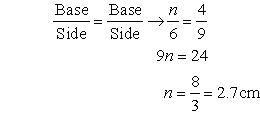 username@email.com
username@email.com
Now let’s turn our attention to ratios and proportions. We’ll also discuss the idea of scale, and see how this applies to a geometric figure.
A ratio is a quotient used to compare two numbers.
A ratio can be represented:
 )
)Although a ratio may look like a fraction, it can have a larger first number (top) than second number (bottom).
A proportion is two or more ratios that are equivalent to each other. In a proportion, the cross products are equal. Cross products are the result of multiplying on the diagonal across the equal sign.

Step 1. Cross multiply.
Step 2. Use division to solve for the variable.
Let’s look at another proportion:

The method for solving proportions is always the same: cross multiply and isolate the variable. But it may take more than two steps to get the variable alone, as in the following examples.
Solve 
Cross multiply: 20(x+4) = 90
Distributive Property: 20x + 80 = 90
Subtract 80 from both sides: 20x = 10
Divide both sides by 20: 
The ratio of women to men at a party is 4 : 3. If there are 120 men at the party, how many women are there?
The correct answer is C. One way to set up the proportion is  . Cross multiply to get 3w =480, and then divide both sides by three to get 160 women.
. Cross multiply to get 3w =480, and then divide both sides by three to get 160 women.
Scale drawings, including maps, are common examples that require proportional reasoning. Sometimes you don’t have to go through all the formal steps of solving a proportion to find out the information you are seeking, but it’s proportional reasoning nonetheless.
The scale on a map is 1 inch : 300 miles. If the distance from Phoenix to Los Angeles on this map is  inches, how many miles is it?
inches, how many miles is it?
1 inch : 300 mi = 2.25 inches : x miles
x = 675 miles
The same process works for comparing the size of regular objects to models of those objects. Model trains, planes, and cars often state the ratio of model size to real size.
A model car is five inches long and three inches wide. If the actual car is 17 feet long, how wide is it?

5w = 51
w = 10.2 feet
A set of construction drawings for a house has a scale of 1 inch : 2 feet. The house is going to be 28 feet tall at its highest point. How many inches is that on the drawing?
The correct answer is A. The number of inches on the drawing is half the number of feet in reality, so divide 28 by 2.
With similar triangles and other similar figures, the lengths of the sides in the figures are in proportion to each other. There are a number of ways to set up the proportion for these types of problems, and the key is to keep like information together.


A 25-foot tall flagpole is casting a shadow 30 feet long. A person standing nearby casts a shadow 7 feet long. How tall is the person?
Start by making a sketch:


Next, try this one yourself.
Find the missing length on the pair of similar triangles below.

The correct choice is B. Set up the proportion and cross-multiply.
